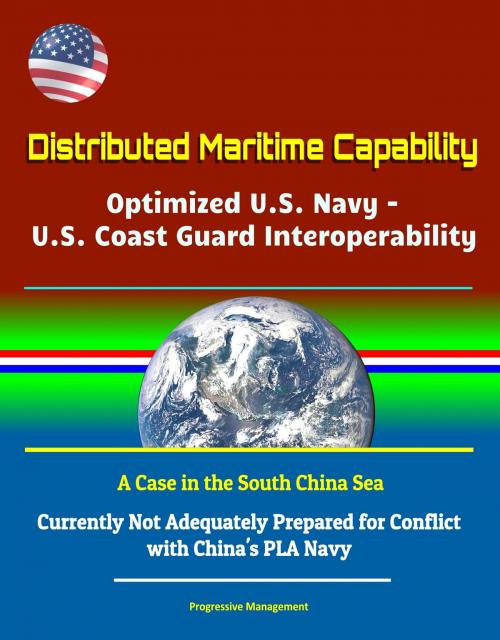Distributed Maritime Capability: Optimized U.S. Navy - U.S. Coast Guard Interoperability, A Case in the South China Sea - Currently Not Adequately Prepared for Conflict with China's PLA Navy
Nonfiction, History, Asian, China, Military, Naval| Author: | Progressive Management | ISBN: | 9780463095003 |
| Publisher: | Progressive Management | Publication: | June 21, 2018 |
| Imprint: | Smashwords Edition | Language: | English |
| Author: | Progressive Management |
| ISBN: | 9780463095003 |
| Publisher: | Progressive Management |
| Publication: | June 21, 2018 |
| Imprint: | Smashwords Edition |
| Language: | English |
This important December 2017 report has been professionally converted for accurate flowing-text e-book format reproduction.
This study asks whether or not the U.S. Navy (USN) and U.S. Coast Guard (USCG) are sufficiently prepared to operate together if conflict escalates in an area of forward-deployed operations and investigates opportunities for naval interoperability to be bolstered if required. Today, the USN faces naval power constraints, specifically ship-force deficiencies. Comparatively, competitors like China are modernizing their naval forces, which are on a path to surpass U.S. naval power. The conclusion is that the USN and USCG are not yet adequately prepared to operate together if conflict arises abroad. One solution is to optimize USN-USCG interoperability through enhancing the USN distributed lethality concept to distributed maritime capabilities—the use of the USCG as a force multiplier.
The distributed maritime capability model is based on an examination of USCG capabilities during conflict as well as independent and joint naval operations. China is assessed to be a dominant aggressor in the South China Sea that poses a threat to regional security and economic stability—major U.S. national interests. Distributed maritime capability is demonstrated by applying the concept to fisheries enforcement in the South China Sea in order to suppress the Chinese Maritime Militia (CMM), which is identified through this study as China's primary means of coercion and the major threat to stability in the region.
I. PROPOSING AN OPTIMIZED INTEROPERABILITY SOLUTION * A. MAJOR RESEARCH QUESTIONS * B. SIGNIFICANCE OF THE RESEARCH QUESTIONS * C. LITERATURE REVIEW * 1. Origins of Maritime Conflicts * 2. A Likely Antagonist at Sea * 3. Interoperability Efforts Countering Conflicts at Sea * D. POTENTIAL EXPLANATIONS AND HYPOTHESES * E. RESEARCH DESIGN * F. STUDY OVERVIEW * II. ASSESSING THE VALUE GAINED FROM USN-USCG INTEROPERABILITY * A. INTRODUCTION * B. THE USCG, A COAST GUARD FORCE AND MORE * C. USCG AND USN ROLES AND CAPABILITIES * 1. U.S. Coast Guard * 2. U.S. Navy * D. USN-USCG INTEROPERABILITY * 1. Historic Accounts * 2. Maritime Interdiction Operations (MIO) * 3. MIO-Counterdrug * 4. MIO-Counter-Piracy * 5. Best Practices * III. USN-USCG INTEROPERABILITY, A CASE FOR THE SOUTH CHINA SEA * A. INTRODUCTION * B. SOUTH CHINA SEA: U.S. INTERESTS AND CONCERNS * 1. Economic * 2. Political * 3. Security * 4. The Rising Hegemon * C. CONDITIONS FOR CONFLICT ESCALATION IN THE SOUTH CHINA SEA * 1. The Rejection of UNCLOS * 2. Coercive Behavior * 3. Militarization of the South China Sea * 4. Lack of ASEAN Might * D. BOLSTERING THE USN BY BRINGING IN THE USCG TO DE-ESCALATE THE ASIA-PACIFIC REGION * 1. A Proportional Force In Partnership * 2. A Proportional Force as a Coast Guard Force * 3. An Operationally Practical Option * 4. Increasing USCG Presence * E. FISHING FOR A SOLUTION * 1. Linking the Chinese Maritime Militia (CMM) To Illegal Fishing * 2. Setting Up A Legal Framework * 3. Enhanced USN-USCG Interoperability In the South China Sea * IV. CONCLUSION * A. STUDY FINDINGS * 1. Potential Conflicts at Sea Threaten U.S. and Allies' Interests * 2. Current U.S. Naval Forces Need Optimal Force to Meet Threats * 3. Distributed Maritime Capability Answers Force Multiplier Need * B. RECOMMENDATIONS * C. FUTURE RESEARCH * D. SIGNIFICANCE
This important December 2017 report has been professionally converted for accurate flowing-text e-book format reproduction.
This study asks whether or not the U.S. Navy (USN) and U.S. Coast Guard (USCG) are sufficiently prepared to operate together if conflict escalates in an area of forward-deployed operations and investigates opportunities for naval interoperability to be bolstered if required. Today, the USN faces naval power constraints, specifically ship-force deficiencies. Comparatively, competitors like China are modernizing their naval forces, which are on a path to surpass U.S. naval power. The conclusion is that the USN and USCG are not yet adequately prepared to operate together if conflict arises abroad. One solution is to optimize USN-USCG interoperability through enhancing the USN distributed lethality concept to distributed maritime capabilities—the use of the USCG as a force multiplier.
The distributed maritime capability model is based on an examination of USCG capabilities during conflict as well as independent and joint naval operations. China is assessed to be a dominant aggressor in the South China Sea that poses a threat to regional security and economic stability—major U.S. national interests. Distributed maritime capability is demonstrated by applying the concept to fisheries enforcement in the South China Sea in order to suppress the Chinese Maritime Militia (CMM), which is identified through this study as China's primary means of coercion and the major threat to stability in the region.
I. PROPOSING AN OPTIMIZED INTEROPERABILITY SOLUTION * A. MAJOR RESEARCH QUESTIONS * B. SIGNIFICANCE OF THE RESEARCH QUESTIONS * C. LITERATURE REVIEW * 1. Origins of Maritime Conflicts * 2. A Likely Antagonist at Sea * 3. Interoperability Efforts Countering Conflicts at Sea * D. POTENTIAL EXPLANATIONS AND HYPOTHESES * E. RESEARCH DESIGN * F. STUDY OVERVIEW * II. ASSESSING THE VALUE GAINED FROM USN-USCG INTEROPERABILITY * A. INTRODUCTION * B. THE USCG, A COAST GUARD FORCE AND MORE * C. USCG AND USN ROLES AND CAPABILITIES * 1. U.S. Coast Guard * 2. U.S. Navy * D. USN-USCG INTEROPERABILITY * 1. Historic Accounts * 2. Maritime Interdiction Operations (MIO) * 3. MIO-Counterdrug * 4. MIO-Counter-Piracy * 5. Best Practices * III. USN-USCG INTEROPERABILITY, A CASE FOR THE SOUTH CHINA SEA * A. INTRODUCTION * B. SOUTH CHINA SEA: U.S. INTERESTS AND CONCERNS * 1. Economic * 2. Political * 3. Security * 4. The Rising Hegemon * C. CONDITIONS FOR CONFLICT ESCALATION IN THE SOUTH CHINA SEA * 1. The Rejection of UNCLOS * 2. Coercive Behavior * 3. Militarization of the South China Sea * 4. Lack of ASEAN Might * D. BOLSTERING THE USN BY BRINGING IN THE USCG TO DE-ESCALATE THE ASIA-PACIFIC REGION * 1. A Proportional Force In Partnership * 2. A Proportional Force as a Coast Guard Force * 3. An Operationally Practical Option * 4. Increasing USCG Presence * E. FISHING FOR A SOLUTION * 1. Linking the Chinese Maritime Militia (CMM) To Illegal Fishing * 2. Setting Up A Legal Framework * 3. Enhanced USN-USCG Interoperability In the South China Sea * IV. CONCLUSION * A. STUDY FINDINGS * 1. Potential Conflicts at Sea Threaten U.S. and Allies' Interests * 2. Current U.S. Naval Forces Need Optimal Force to Meet Threats * 3. Distributed Maritime Capability Answers Force Multiplier Need * B. RECOMMENDATIONS * C. FUTURE RESEARCH * D. SIGNIFICANCE















